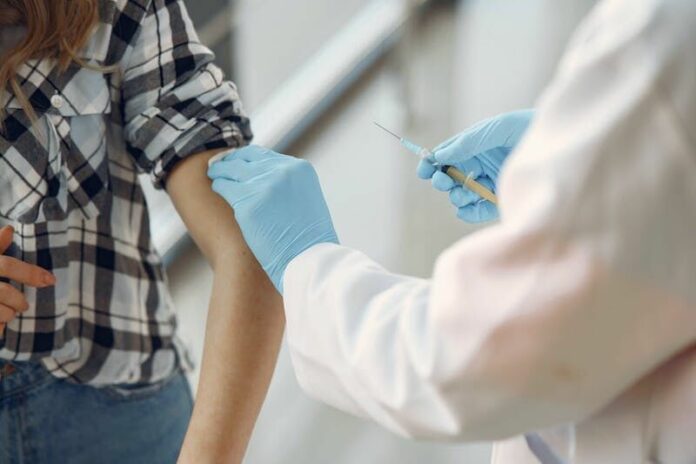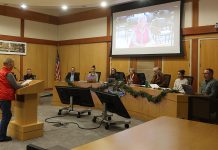A panel of Sonoma County representatives discussed the latest numbers and developments of the county’s rollout strategy focusing on equity at the Feb. 3 online community briefing and Q&A with Health Officer Dr. Sundari Mase.
District 5 Supervisor Lynda Hopkins said the county is pursuing an equitable vaccine rollout strategy of collaborating with groups that work with low-income seniors, residents with underlying health conditions and the Latinx community.
Bringing home that two-thirds of the lives lost to COVID-19 in the county were locals ages 75 and older, she also called attention to how the county’s Latinx population accounted for 90% of positive cases at one point, comprising a significant number of the essential workers at higher risk of contracting the virus.
Hopkins acknowledged and apologized for the recent botched vaccine rollout at the Rohnert Park Community Center clinic, where many under the age of 75 sought appointments through OptumServe, a pilot vaccination program the county participates in.
Office of Equity Director Alegría De La Cruz said equity issues billowed out from the state’s move to extend vaccine availability to those ages 65 and older in the same tier as at-risk essential workers, slated in the county’s vaccine distribution plan online as those working in education and childcare, emergency services and food and agriculture.
“Although low-income communities of color have been hardest hit by COVID-19, in many areas, including our own, people from wealthier and largely white communities flooded our vaccination systems,” she said. “That shift made it so that people working essential jobs may not receive their vaccines as quickly.”
De La Cruz said the county is engaging leaders of some of the hardest hit communities — low-income communities of color — to strategize around logistical obstacles like limited access to technology, transportation and time, turning to organizations and healthcare providers as well.
“The same challenges that led to those communities being at high levels of risk for COVID infection are the same challenges that lead to those communities being at risk for not being vaccinated,” she said later on.
According to Kathryn Pack, health program manager for the county’s epidemiology group, recent data indicates 10% of fully vaccinated residents and 9% of residents with one dose are Latinx. As of Feb. 4, she said the data shows 59% of those fully vaccinated and 52% of those who’ve received their first dose are white and non-Hispanic.
She said the county will upload current demographic data on those fully vaccinated soon. Neither data set includes the percentage of residents with missing racial and ethnic data, she said, which if factored in would have comprised 26% of those fully vaccinated and 10% of those with their first dose.
Health care workers make up most of those fully vaccinated and those with one dose are increasingly ages 75 and older, Pack said.
According to De La Cruz, most essential workers are Indigenous-language speakers and Latinx residents, and the equity approach focuses on those endangered by “our economy,”
who may struggle through several jobs, a language barrier and unreliable access to internet, technology and primary care.
“They have the riskiest jobs, they have the most crowded housing, they don’t have safe and regular access to those systems that keep us healthy and safe, whether it’s healthcare or unemployment insurance,” she said.
Agricultural workers with H-2A visas are on De La Cruz’s mind, living in congregant housing, depending on employers for transportation and new to U.S. systems.
“If our systems create those risks for people, then the system that addresses how to reduce those risks also really needs to take into consideration all of those different characteristics of that person that we’re holding in the center of this process,” she said.
Denia Candela, the county health department’s equity program manager, said the rollout strategy evolves to incorporate an equity framework focusing on those most at-risk residents, taking a culturally responsive approach and “providing transparency in the science and the vaccination process.”
Building an equitable vaccine plan means communicating the vaccine is safe and “being able to acknowledge the negative impacts and painful history that our healthcare systems have had in communities of color that really have led to the distrust of the research and government entities,” she said.
The county actively seeks bilingual, multilingual and multicultural staff, including Indigenous language speakers, to be present to support community members at clinics. The county will also request that all clinics receiving vaccines from the county embrace the county’s equity framework, she said.
According to Candela, the framework assesses whether a proposed clinic is within reach of neighborhoods, the distance between testing and vaccination sites, and encourages that culturally relevant resources and multilingual, multicultural staff be on hand.
Hopkins prompted the panel to address whether leaning on online appointment systems, social media and the internet to share vaccination opportunities can actually worsen equity.
COVID-19 testing yielded the wisdom that word of mouth and outreach through family resource centers and other trusted community organizations works well, but “social media definitely doesn’t play in our advantage” reaching vulnerable populations, Candela said.
The county has community leaders and organizations to thank for doing the work of holding the county accountable, spreading awareness and even helping people fill out their forms, according to De La Cruz.
“They told us, ‘Don’t do it this way.’ So, we knew that, and we’ve been developing a different way that’s really in line with those lessons from our communities,” she said.
Hopkins said staff, nonprofits and volunteers have been calling community members directly.
OptumServe now has a phone line and there’s effort to ensure someone is staffing that line at the different clinics, Candela said.
Department of Health Services Director Barbie Robinson and Hopkins voiced reservations about news of a state vaccine distribution system with a third-party administrator on the horizon.
“It’s my understanding that the state will be releasing the contract for the third-party administrator on Feb. 15. I do not know what’s in that scope of work,” she said, and that various health departments have told the state they want details.
Robinson said the lack of information is troubling since “we know best at the local level how to address equity,” building community relationships to overcome accessibility barriers.
Hopkins said, “As frustrating as the fragmented system has been, there is a little concern about, ‘Is this going to be trying to be a one size fits all kind of solution?’”
She also spoke to the county’s local partners that at-risk groups trust and unanswered questions of whether the more centralized system will be culturally competent, adaptable to the unique considerations facing each county or mandated.
“I really want to emphasize that it’s unclear to us what this third-party administrator contract is going to solve. We’re unclear of what the problem is specifically that they’re trying to solve, and for us, the biggest issue is the lack of supply,” Robinson said. “I cannot emphasize that enough. That really is the crux of the challenge that we have.”









